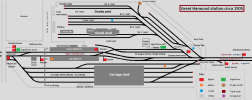I've really only have one thing I need to clear up now about my old line (Great Harwood loop line) - sorry it's this line again!
I have on very good authority that at Great Harwood (GH) in September 1965 around 120 wagons were removed from GH so the track removal could begin.
Now, there are two things to note:
1. The line West of Padiham closed November 1964 (almost a year before) i.e GH and Simnostone section.
2. I know from official BR records GH was only receiving 9 wagons per week (on average).
Question:
How could GH end up with 120 wagons between November '64 and September '65 when this section is closed to traffic?
Many of you have told me it was quite common to store withdrawn engines on closed lines. Did BR do something similar with wagons i.e. store some on closed lines? if so, it begs the question when is a closed line actually closed.
The fact that 120 wagons accumulated at GH suggests there must have been some moment along the line at GH.
The 120 wagons were stored in the carriage shed sidings. I have attached my own schematic diagram of GH (circa 1905 but the layout remained unchanged until closure).
Thanks,
Andy.
I have on very good authority that at Great Harwood (GH) in September 1965 around 120 wagons were removed from GH so the track removal could begin.
Now, there are two things to note:
1. The line West of Padiham closed November 1964 (almost a year before) i.e GH and Simnostone section.
2. I know from official BR records GH was only receiving 9 wagons per week (on average).
Question:
How could GH end up with 120 wagons between November '64 and September '65 when this section is closed to traffic?
Many of you have told me it was quite common to store withdrawn engines on closed lines. Did BR do something similar with wagons i.e. store some on closed lines? if so, it begs the question when is a closed line actually closed.
The fact that 120 wagons accumulated at GH suggests there must have been some moment along the line at GH.
The 120 wagons were stored in the carriage shed sidings. I have attached my own schematic diagram of GH (circa 1905 but the layout remained unchanged until closure).
Thanks,
Andy.

